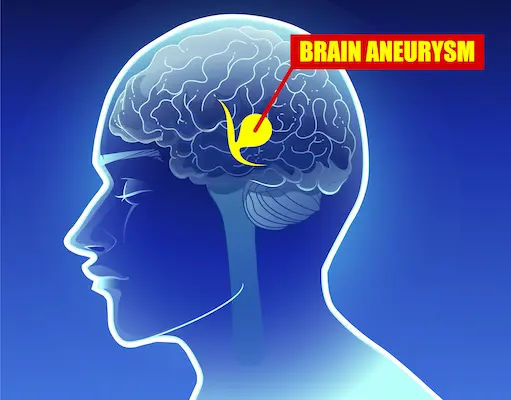Brain Aneurysm Symptoms, Causes, and Treatment
Learn about brain aneurysms, including their symptoms, causes, risk factors, and treatment options to protect your brain health.

Written by Dr. Mohammed Kamran
Reviewed by Dr. Shaik Abdul Kalam MD (Physician)
Last updated on 24th Sep, 2025

Introduction
The term "brain aneurysm" often evokes a sense of fear and uncertainty. Many people are unaware they have one until a critical moment, which is why understanding this condition is so vital for your health. Simply put, a brain aneurysm is a weak, bulging spot on the wall of a brain artery, much like a thin, overinflated balloon. While often silent and harmless, a ruptured brain aneurysm is a life-threatening medical emergency that causes bleeding into the brain. This guide aims to demystify brain aneurysms, moving beyond the fear to provide clear, actionable information. We will walk you through everything from the subtle early signs and key risk factors to the latest diagnostic techniques and treatment options. Our goal is to empower you with knowledge, so you can recognise the warning signs and take proactive steps for your neurological health.
What is a Brain Aneurysm? The "Berry" on the Artery
A brain aneurysm, also known as a cerebral or intracranial aneurysm, is not a tumour or a growth. It is a structural problem with a blood vessel. Over time, pressure from blood flow can push against a weakened spot in the artery wall, causing it to bulge outward. The most common type is called a saccular or "berry" aneurysm because it resembles a berry hanging from a vine. These typically form at branch points in the arteries at the base of the brain. While the thought of having a bulge in a brain artery can be alarming, it's crucial to know that the vast majority of aneurysms do not rupture. Many are small and remain stable, never causing any symptoms or problems throughout a person's life.
How Common Are Brain Aneurysms?
It's estimated that up to 1 in 50 people in the United States may have an unruptured brain aneurysm, though many figures suggest a range of 3-5% of the population. This means they are more common than many people realise. The prevalence is higher in people with certain risk factors, such as a family history, high blood pressure, or smoking. Fortunately, only a small fraction of these aneurysms will ever rupture. Understanding the statistics helps put the risk into perspective; while vigilance is important, it should not lead to undue anxiety.
Consult a Neurosurgeon for the best advice
Recognising the Signs: Symptoms of a Brain Aneurysm
Symptoms depend entirely on whether the aneurysm is intact (unruptured) or has burst (ruptured). Many people live their entire lives with an unruptured aneurysm and never know it.
The Silent Threat: Unruptured Aneurysm Symptoms
Most unruptured brain aneurysms are asymptomatic. However, if an aneurysm becomes large enough, it can press on nerves or brain tissue, leading to warning signs. These can include:
• Pain above or behind one eye: A localised, persistent pain.
• A dilated pupil: The pupil of one eye may become noticeably larger.
• Double vision or blurred vision: Pressure on nerves controlling eye movement.
• Numbness or weakness on one side of the face.
If you experience any of these symptoms persistently, it is essential to consult a doctor.
A Medical Emergency: Ruptured Aneurysm Symptoms
A ruptured aneurysm causes a hemorrhagic stroke, known as a subarachnoid haemorrhage. The symptoms are sudden and severe. The most common and characteristic sign is a thunderclap headache.
A Sudden, Severe Headache: Often described as "the worst headache of my life." It hits with maximum intensity instantly.
• Nausea and Vomiting
• Stiff Neck
• Sensitivity to Light (Photophobia)
• Seizure
• Loss of Consciousness or Confusion
Understanding a Sentinel Headache
In some cases, a small leak may occur before a major rupture. This is called a sentinel bleed or sentinel headache. It causes a sudden, severe headache that may resolve on its own. This is a critical warning sign of an impending rupture and requires immediate medical attention. Never ignore a sudden, severe headache.
What Causes a Brain Aneurysm to Develop?
The exact cause of a brain aneurysm is not always clear. They are thought to result from a combination of factors that weaken the arterial wall over time. Some people may be born with a predisposition due to weaknesses in the layers of the artery wall. Over a lifetime, constant pressure from blood flow can stress these weak points, leading to the formation of a bulge.
Key Risk Factors You Should Know
While the cause is multifactorial, several well-established risk factors increase the likelihood of developing and rupturing a brain aneurysm.
Non-Modifiable Risk Factors (You Can't Change)
• Family History: Having a first-degree relative (parent, sibling, or child) with a brain aneurysm significantly increases your risk.
• Age: The risk increases with age, peaking in adults between 40 and 60.
• Gender: Women are more likely than men to develop a brain aneurysm and suffer a rupture.
• Genetic Conditions: Certain disorders, like Polycystic Kidney Disease, Ehlers-Danlos syndrome, and Marfan syndrome, are associated with weaker blood walls.
Modifiable Risk Factors (You Can Influence)
• High Blood Pressure (Hypertension): This is a major risk factor, as it puts constant stress on artery walls.
• Smoking: This is one of the strongest and most modifiable risk factors. It damages and weakens blood vessels.
• Excessive Alcohol Consumption: Particularly binge drinking, which can cause sudden spikes in blood pressure.
• Drug Abuse: The use of stimulants like cocaine can severely damage blood vessels and dramatically increase blood pressure.
How is a Brain Aneurysm Diagnosed?
If a doctor suspects a brain aneurysm based on symptoms or risk factors, they will order imaging tests. These are the gold standard for diagnosis.
• Computed Tomography (CT) Scan: This is usually the first test done in an emergency for a suspected rupture. It can quickly detect bleeding in the brain.
• CT Angiography (CTA): A special dye is injected into the bloodstream to make blood vessels visible on the CT scan, providing a detailed map of the arteries in the brain.
• Magnetic Resonance Angiography (MRA): This uses magnetic fields and radio waves to create detailed images of blood vessels. It is often used for screening individuals with a strong family history.
• Cerebral Angiogram: This is the most detailed test. A thin tube (catheter) is threaded from the groin to the brain arteries, and dye is injected. It provides a highly precise view of the aneurysm's size, shape, and location and is often used to guide treatment.
Treatment Options: Repairing the Weakness
The decision to treat an unruptured aneurysm depends on its size, location, shape, the patient's age and overall health, and family history. Small, stable aneurysms may simply be monitored with regular imaging. The goal of treatment is to prevent a rupture by sealing off the aneurysm from the normal blood circulation. The two primary methods are surgical clipping and endovascular coiling.
Surgical Clipping: A Direct Approach
This is a traditional open-brain surgery. A neurosurgeon removes a small section of the skull to access the aneurysm. A tiny metal clip is placed across the neck (base) of the aneurysm, stopping blood flow into it. The clip remains in place permanently. This is a highly effective and durable treatment but is invasive and requires a longer recovery time.
Endovascular Coiling: A Less Invasive Procedure
This is a less invasive alternative. The surgeon threads a catheter through an artery in the groin up to the brain aneurysm. Through the catheter, they place soft platinum coils into the aneurysm. The coils promote blood clotting inside the aneurysm, sealing it off from the artery. Recovery from coiling is typically faster than from clipping.
Flow Diverters and Other Advanced Techniques
For complex aneurysms, newer devices like flow diverters (stent-like tubes) can be placed in the main artery. They redirect blood flow away from the aneurysm, causing it to clot and eventually shrink. Other options include stent-assisted coiling, where a stent holds the coils in place within a wide-necked aneurysm.
Life After a Brain Aneurysm: Recovery and Outlook
Recovery varies dramatically depending on whether the aneurysm was unruptured or ruptured. Recovery from treatment for an unruptured aneurysm is often straightforward, with patients returning to normal activities within a few weeks. Recovery from a ruptured aneurysm, however, is a long and challenging journey. It can involve rehabilitation for physical, cognitive, and emotional challenges caused by the brain bleed. The survival rate for a ruptured aneurysm is about 50%, and about two-thirds of survivors have some permanent neurological deficit. Early intervention is critical for a better outcome.
Can a Brain Aneurysm Be Prevented?
There is no guaranteed way to prevent a brain aneurysm, but you can significantly reduce your risk by managing the modifiable risk factors:
• Control Blood Pressure: Monitor and manage hypertension through diet, exercise, and medication if prescribed.
• Quit Smoking: This is the single most impactful change you can make.
• Eat a Healthy Diet and Exercise Regularly.
• Limit Alcohol and Avoid Recreational Drugs.
• If you have a strong family history, talk to your doctor about the potential benefits of screening.
Conclusion
Understanding brain aneurysms is the first step toward overcoming the fear associated with them. While a ruptured aneurysm is a serious crisis, it's important to remember that many people live with unruptured aneurysms without ever experiencing a problem. Knowledge empowers you to take action, whether that's adopting a healthier lifestyle to mitigate risk factors, knowing when to seek emergency help for a sudden severe headache, or having an informed discussion with a specialist if an aneurysm is discovered. Your brain health is paramount. If you have concerns based on family history or symptoms, do not hesitate to seek professional medical advice. Taking proactive steps today can make all the difference for your neurological well-being tomorrow.
Consult a Neurosurgeon for the best advice
Consult a Neurosurgeon for the best advice

Dr. Gopal Achari
Neurosurgeon
20 Years • MBBS, MS (GEN SUR), MCH (NEURO SUR)
Kolkata
Apollo Multispeciality Hospitals , Kolkata, Kolkata

Dr. Aditendraditya Singh Bhati
Neurosurgeon
18 Years • MBBS(2004), DNB Neurosurgery(2014); MNAMS; Fellow Neuroendoscopy
Delhi
Apollo Hospitals Indraprastha, Delhi
(100+ Patients)

Dr Debnath Dwaipayan
Neurosurgeon
9 Years • MBBS, MS(Gen. Surgery), DrNB (Neurosurgery)
Delhi
Apollo Hospitals Indraprastha, Delhi

Dr. Sunit Mediratta
Neurosurgeon
20 Years • MBBS, MS, MCh, DNB, MNAMS
Delhi
Apollo Hospitals Indraprastha, Delhi
Dr. Sanatan Satapathy
Neurosurgeon
10 Years • MBBS , MS (General surgery) , MCH (Neurosurgery)
Bhubaneswar
Dr Sanatan Satapathy, Bhubaneswar
Consult a Neurosurgeon for the best advice

Dr. Gopal Achari
Neurosurgeon
20 Years • MBBS, MS (GEN SUR), MCH (NEURO SUR)
Kolkata
Apollo Multispeciality Hospitals , Kolkata, Kolkata

Dr. Aditendraditya Singh Bhati
Neurosurgeon
18 Years • MBBS(2004), DNB Neurosurgery(2014); MNAMS; Fellow Neuroendoscopy
Delhi
Apollo Hospitals Indraprastha, Delhi
(100+ Patients)

Dr Debnath Dwaipayan
Neurosurgeon
9 Years • MBBS, MS(Gen. Surgery), DrNB (Neurosurgery)
Delhi
Apollo Hospitals Indraprastha, Delhi

Dr. Sunit Mediratta
Neurosurgeon
20 Years • MBBS, MS, MCh, DNB, MNAMS
Delhi
Apollo Hospitals Indraprastha, Delhi
Dr. Sanatan Satapathy
Neurosurgeon
10 Years • MBBS , MS (General surgery) , MCH (Neurosurgery)
Bhubaneswar
Dr Sanatan Satapathy, Bhubaneswar
More articles from Brain Aneurysm
Frequently Asked Questions
1. What does a brain aneurysm headache feel like?
A ruptured brain aneurysm headache is typically described as a sudden, explosive 'thunderclap' headache, the worst headache of one's life. It reaches peak intensity in seconds. This is distinct from a migraine or tension headache, which usually builds up gradually.
2. Can stress cause a brain aneurysm to rupture?
While chronic stress can contribute to high blood pressure (a risk factor), there is no direct evidence that a single stressful event can cause a rupture. However, sudden, extreme physical exertion or a sharp rise in blood pressure could theoretically increase the risk in an already vulnerable aneurysm.
3. What is the survival rate for a ruptured brain aneurysm?
Approximately 50% of people who experience a ruptured brain aneurysm do not survive beyond the first 24 hours. Of those who do survive, about two-thirds will have some form of permanent neurological disability. Early treatment is critical for survival and a better recovery.
4. Are there warning signs days before an aneurysm ruptures?
Sometimes, a sentinel headache caused by a small leak can occur days or weeks before a major rupture. This serves as a critical warning sign. Other warning signs of an unruptured aneurysm, like vision changes or eye pain, may also be present if the aneurysm is large enough to press on nerves.
5. How long is brain aneurysm surgery recovery?
Recovery from minimally invasive endovascular coiling may take a few weeks. Recovery from open surgical clipping is longer, often taking several weeks to months to return to all normal activities. Recovery from a rupture itself is a much longer process, involving extensive rehabilitation.

.webp)